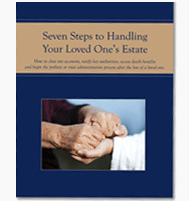TOD Beneficiary: What You Should Know | Silicon Valley Estate Attorney

Your named beneficiaries will likely have to go through probate to receive your real property after your death if it is only in your name and not held in trust. Although transferring property into trust can ensure your family does not have to wait for a judge to validate your will before distributing your assets, it might not make sense for your situation.
Another method is a transfer-on-death (TOD) deed. A TOD deed transfers a person’s real property to named beneficiaries upon the transferor’s death. It is similar to a transfer-on-death registration for an investment account or a payable-on-death designation for a bank account.
You have control over your real property during your lifetime, even with a TOD beneficiary designation. You can choose to keep it, sell it, or do anything else you want. You are also responsible for the taxes and mortgage on the property. If you still own the property when you die (and your named beneficiaries survive you), the TOD deed will avoid probate and automatically transfer the property to your beneficiaries.
How to Set Up a TOD Deed
Not all states have laws allowing TOD deeds. The property you own must be in a state with TOD deed laws. The steps to create a deed differ from one state to another but typically require that you:
- Draft the deed – First, you must draft the TOD deed and ensure it complies with state laws. If you live in one state and your property is in another, you must follow the laws of the state where the property is situated. The language should clarify that the deed isn’t effective until you die. Until then, you have total control over the property.
- Choose a beneficiary – You can choose one or multiple people and/or organizations as your beneficiary. You should plan for the unexpected and name alternate beneficiaries in case the first one passes away before you do. If you choose more than one beneficiary, you should indicate how they should split the property. For example, if the law allows it, you can decide whether two beneficiaries will have equal ownership shares.
- Provide a legal description – You must use the proper legal description in your deed to describe the property. Official property records, mortgage documents, or sales contracts should contain this language.
- Sign the deed – Your TOD deed won’t be legally enforceable unless you sign it. You should be the only person required to sign if you are the sole owner of the property. If you’re married and live in a community property state, your spouse might have to sign the deed, as well. Co-owning property with someone as tenants in common allows you to designate a TOD beneficiary only for your share of the property. All co-owners must sign the deed, and, depending on how the co-owners hold title, the TOD deed may not be effective until the last surviving owner dies.
- Record the deed – You might need to sign the deed in front of a notary public, depending on state laws. You should file it with the appropriate land records authority, such as a land registrar, county clerk, or recorder’s office. This is a vital step because the TOD deed will not be valid and legally enforceable unless you record it. Your beneficiary cannot record it after your death (though some state laws do allow for a short grace period).
Contact Us Today to Speak with an Experienced Silicon Valley Estate Lawyer
Do not hesitate to contact us if you’re considering creating a TOD deed. There are numerous disadvantages to using a TOD deed rather than a more robust plan such as a living trust, but if a TOD deed is right for you, it’s important to do it correctly. Since you must follow various state laws and procedures to file a valid deed, using an experienced lawyer to assist you is critical.
Drafting your own deed could lead to a range of complications. If you make a mistake, your beneficiaries might not be able to receive your property without going to court first. Additionally, confusion about the language in the document could create disputes within your family and require a judge to resolve the issue. Don’t go it alone; let us help. To schedule an appointment at our Santa Clara law firm, simply call 408-889-1290.
Another method is a transfer-on-death (TOD) deed. A TOD deed transfers a person’s real property to named beneficiaries upon the transferor’s death. It is similar to a transfer-on-death registration for an investment account or a payable-on-death designation for a bank account.
You have control over your real property during your lifetime, even with a TOD beneficiary designation. You can choose to keep it, sell it, or do anything else you want. You are also responsible for the taxes and mortgage on the property. If you still own the property when you die (and your named beneficiaries survive you), the TOD deed will avoid probate and automatically transfer the property to your beneficiaries.
How to Set Up a TOD Deed
Not all states have laws allowing TOD deeds. The property you own must be in a state with TOD deed laws. The steps to create a deed differ from one state to another but typically require that you:
- Draft the deed – First, you must draft the TOD deed and ensure it complies with state laws. If you live in one state and your property is in another, you must follow the laws of the state where the property is situated. The language should clarify that the deed isn’t effective until you die. Until then, you have total control over the property.
- Choose a beneficiary – You can choose one or multiple people and/or organizations as your beneficiary. You should plan for the unexpected and name alternate beneficiaries in case the first one passes away before you do. If you choose more than one beneficiary, you should indicate how they should split the property. For example, if the law allows it, you can decide whether two beneficiaries will have equal ownership shares.
- Provide a legal description – You must use the proper legal description in your deed to describe the property. Official property records, mortgage documents, or sales contracts should contain this language.
- Sign the deed – Your TOD deed won’t be legally enforceable unless you sign it. You should be the only person required to sign if you are the sole owner of the property. If you’re married and live in a community property state, your spouse might have to sign the deed, as well. Co-owning property with someone as tenants in common allows you to designate a TOD beneficiary only for your share of the property. All co-owners must sign the deed, and, depending on how the co-owners hold title, the TOD deed may not be effective until the last surviving owner dies.
- Record the deed – You might need to sign the deed in front of a notary public, depending on state laws. You should file it with the appropriate land records authority, such as a land registrar, county clerk, or recorder’s office. This is a vital step because the TOD deed will not be valid and legally enforceable unless you record it. Your beneficiary cannot record it after your death (though some state laws do allow for a short grace period).
Contact Us Today to Speak with an Experienced Silicon Valley Estate Lawyer
Do not hesitate to contact us if you’re considering creating a TOD deed. There are numerous disadvantages to using a TOD deed rather than a more robust plan such as a living trust, but if a TOD deed is right for you, it’s important to do it correctly. Since you must follow various state laws and procedures to file a valid deed, using an experienced lawyer to assist you is critical.
Drafting your own deed could lead to a range of complications. If you make a mistake, your beneficiaries might not be able to receive your property without going to court first. Additionally, confusion about the language in the document could create disputes within your family and require a judge to resolve the issue. Don’t go it alone; let us help. To schedule an appointment at our Santa Clara law firm, simply call 408-889-1290.






